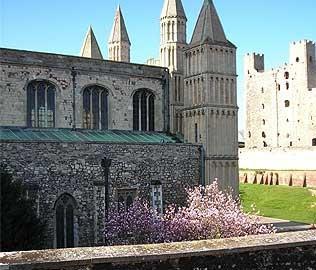A Church in Kent has embraced creative solutions for cutting its emissions. The scheme shows how changes can be made to a listed building while retaining its original features
St Nicholas Church in Rochester has had a sustainable make-over that is set to reduce its carbon footprint by 60% and supplies over half of its energy requirements from renewable resources.
The Grade 1 listed church, which is used as offices by the diocese of Rochester, sits next door to the Rochester Cathedral, so structural or visible changes to the exterior were deemed impossible. Internally, no work could be carried out that would impact on the structural fabric of the building.
Molyneux Architects’ clever approach was to utilise the inherent thermal mass of the church’s stone structure and then design in large secondary glazing screens to guard against heat loss through the massive stained glass windows. These measures vastly improve the insulative performance of the building, which is already passively ventilated throughout the open-plan two storey office space.

Heat retention
Mark Trevett, surveyor for the Diocese, says: “The glazed screens have retained the special feel of working within the church but really cut down the draughts and made the space much more pleasant to work in.”Externally, a 5 kW array of photovoltaic panels has been installed behind a parapet wall on a flat roof, making it invisible from ground level. This provides sustainable power, along with energy from a 50 kW wood pellet boiler: pellets are sourced from a major wood pellet plant just a few miles away in Northfleet.
Together, these technologies supply the majority of the building’s energy needs. Any excess power generated by the photovoltaic array will be exported to the National Grid. A small gas boiler tops up energy requirements if required, as the physical constraints of the building didn’t allow for as big a wood pellet boiler as the architect would have liked.
Working around constraints
Trevett says: “We are still working out one or two quirks with the wood pellet boiler but the PVs have been running for about a year now and they seem to be working quite efficiently, according to the readouts we’ve taken.”The Diocese decided to do its bit for the environment, knowing that attempting to ‘green’ the building could be difficult and payback periods lengthy. It was assisted in gaining all the right grants and permissions by Creative Environmental Networks, which specialises in engaging home owners, businesses and communities in environmental improvements. Grants for some 50% of the sustainable technologies on the project came from the Energy Saving Trust and capital funding from Scottish Power.
Peter Robinson, sustainable energy project officer with Creative Environmental Networks, says: “If this kind of impact can be made on the carbon emissions of such an ancient building and if it can still retain its character in its historic setting, then it provides an excellent example of how Britain can at least begin to make serious carbon savings without making any drastic changes to our way of life or surroundings.”





























1 Readers' comment